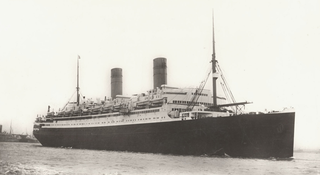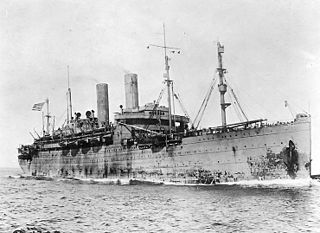Columbus is a Latinized version of the Italian surname "Colombo". It most commonly refers to:

RMS Republic was a steam-powered ocean liner built in 1903 by Harland and Wolff in Belfast, and lost at sea in a collision in 1909 while sailing for the White Star Line. The ship was equipped with a new Marconi wireless telegraphy transmitter, and issued a CQD distress call, resulting in the saving of around 1,500 lives. Known as the "Millionaires' Ship" because of the number of wealthy Americans who traveled by her, she was described as a "palatial liner" and was the flagship of White Star Line's Boston service. This was the first important marine rescue made possible by radio, and brought worldwide attention to this new technology.

USS Freedom (ID-3024) was a cargo and transport ship in the United States Navy during World War I. Originally SS Wittekind for the North German Lloyd line, the ship also served as USAT Iroquois and USAT Freedom after being seized by the United States in 1917.
Norddeutscher Lloyd was a German shipping company. It was founded by Hermann Henrich Meier and Eduard Crüsemann in Bremen on 20 February 1857. It developed into one of the most important German shipping companies of the late 19th and early 20th centuries, and was instrumental in the economic development of Bremen and Bremerhaven. On 1 September 1970, the company merged with Hamburg America Line (HAPAG) to form Hapag-Lloyd AG.

USS Zeppelin was a passenger liner launched in 1914 as SS Zeppelin by Bremer Vulkan, Bremen-Vegesack, Germany, for Norddeutscher Lloyd (NDL). Due to the First World War she never entered NDL service. She had a career after the war first under White Star Line control, then briefly as the troop ship USS Zeppelin, next as the Orient SN Co liner SS Ormuz and finally back with NDL as SS Dresden.

RMS Homeric, originally launched as Columbus, was an ocean liner built for Norddeutscher Lloyd and launched in 1913 at the F. Schichau yard in Danzig, Germany. Columbus was ceded to Great Britain in 1919 as part of German war reparations. She was sold to the White Star Line in 1920, which named her Homeric. Her sister ship Hindenburg remained in German ownership and was renamed Columbus. Homeric was operated by White Star from 1922 to 1935.
Four ships of the White Star Line have been named SS Belgic:

The SS Columbus, was a German ocean liner laid down before the start of World War I. The vessel was originally to be named Hindenburg. However, her then-sister, originally named Columbus, was handed over to British government and then sold to the White Star Line after the war as part of reparations in 1920 and renamed Homeric by her new owners. The Allies allowed the Norddeutscher Lloyd (NDL), her owners, to keep the remaining ship. NDL decided to give her the name of her departed sister, now the British Homeric. Construction, which had been held up by the war, resumed at Schichau Shipyards in Danzig, Germany.

SS George Washington was an ocean liner built in 1908 for the Bremen-based North German Lloyd and was named after George Washington, the first President of the United States. The ship was also known as USS George Washington (ID-3018) and USAT George Washington in service of the United States Navy and United States Army, respectively, during World War I. In the interwar period, she reverted to her original name of SS George Washington. During World War II, the ship was known as both USAT George Washington and, briefly, as USS Catlin (AP-19), in a short, second stint in the U.S. Navy.

USS Mercury (ID-3012) was a United States Navy transport ship during World War I. She was formerly the Norddeutscher Lloyd liner SS Barbarossa built by Blohm & Voss, Hamburg, Germany, in 1897, and operated by the North German Lloyd Line.
A number of ships of the Holland America Line have been named Statendam, the name of an old dike on the island of Goeree-Overflakkee:
SS City of Honolulu may refer to one of these Los Angeles Steamship Company ships:

SS Arabic, originally built as Berlin, was a passenger steamship launched on 7 November 1908 which was built by the AG Weser shipbuilding company in Germany. Her gross register tonnage was advertised at 16,786 tons. She made her maiden voyage on 1 May 1909 from New York to Genoa and Bremerhaven. In September 1914 she became an auxiliary cruiser with the Imperial German Navy as a minelayer.
A number of ships have been named SS Königin Luise:

SS Lapland was a steam ocean liner built in Ireland for the Belgian Red Star Line. When new she was Red Star's flagship: similar in appearance to the company's SS Samland, SS Gothland and SS Poland, but far larger. She was a half sister to White Star Line's "Big Four", just smaller and not as luxurious. They are similar in many ways, such as the island bridge, 4 masts, 2 funnels. But Lapland had a less luxurious interior.

The first RMS Saxonia was a passenger ship of the British Cunard Line. Between 1900 and 1925, Saxonia operated on North Atlantic and Mediterranean passenger routes, and she saw military service during World War I (1914–1918).

SS Albertic was a British ocean liner, originally built as the Norddeutscher Lloyd's München. It was handed to Britain as part of war reparations and served during the 1920s and 1930s.

SS Haverford was an American transatlantic liner commissioned in 1901 for the American Line on the route from Southampton to New York, then quickly on the route from Liverpool to Boston and Philadelphia. During her early years, this ship, mainly designed to transport migrants and goods, was the victim of several incidents. Her company was integrated into the International Mercantile Marine Co. (IMM) in 1902 and she was used by other companies within the trust, the Dominion Line and the Red Star Line.
This page is based on this
Wikipedia article Text is available under the
CC BY-SA 4.0 license; additional terms may apply.
Images, videos and audio are available under their respective licenses.











